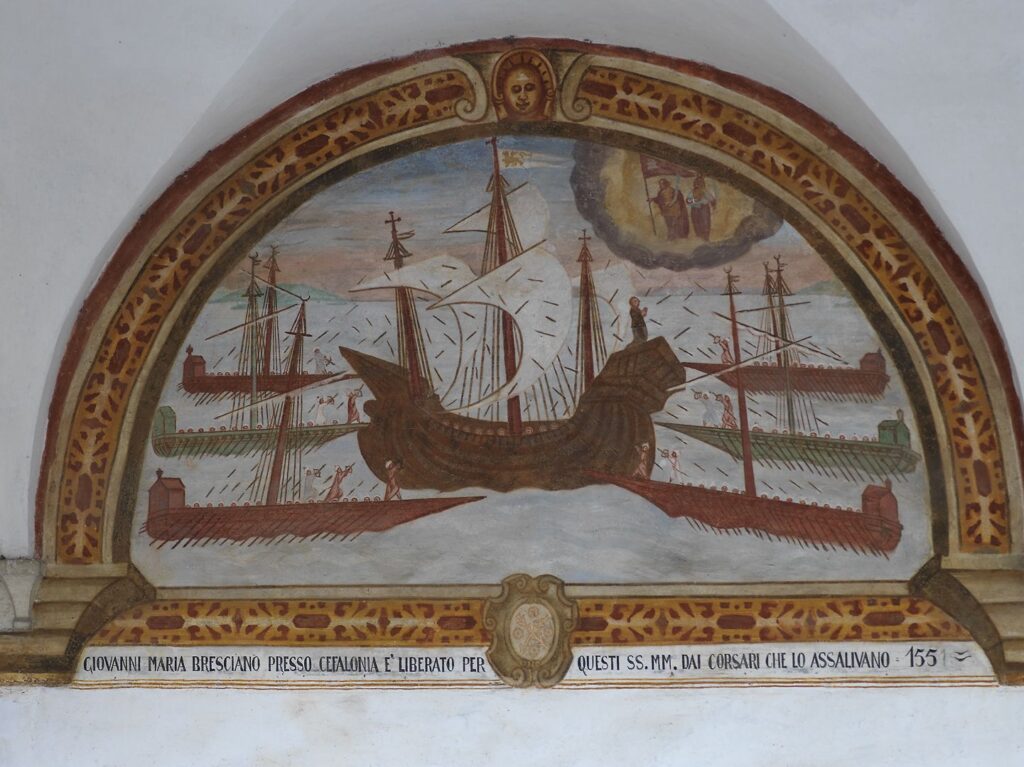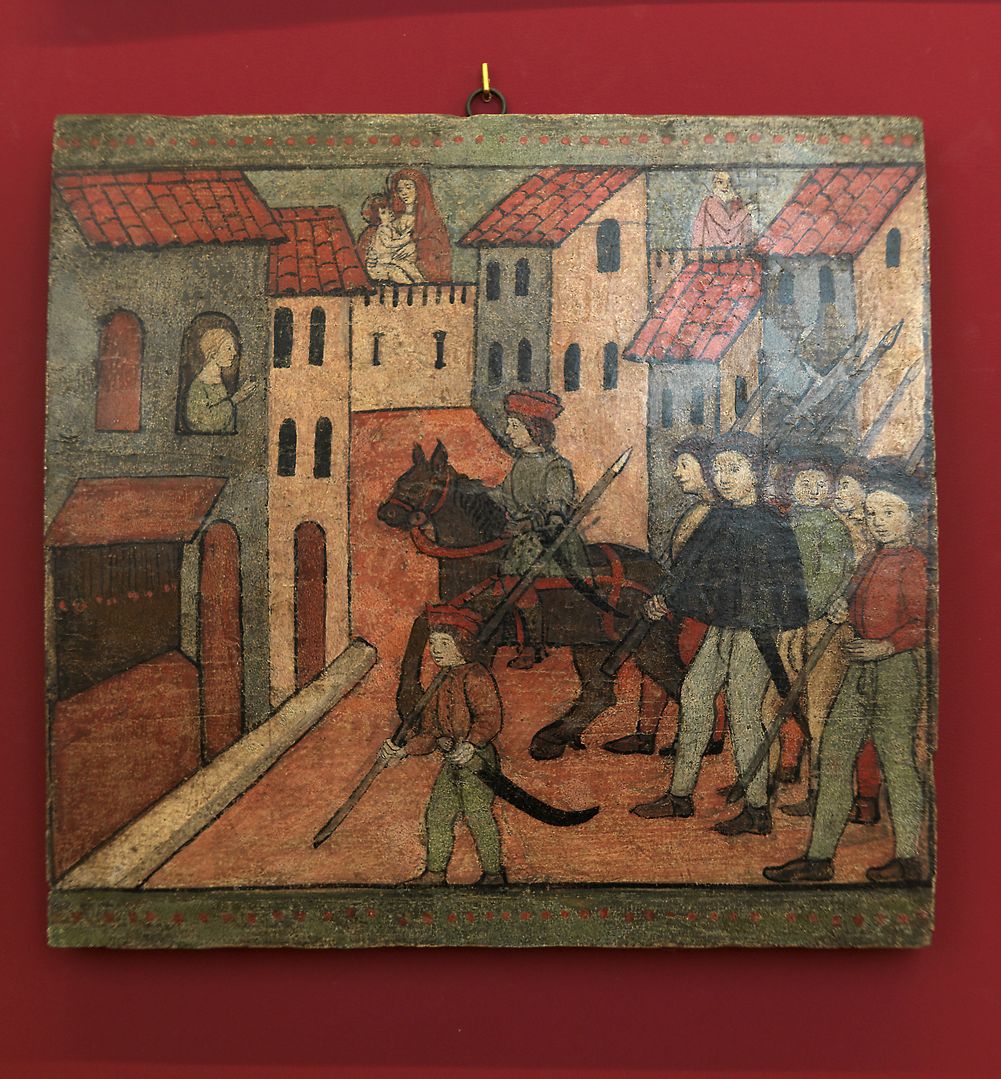On a hillside in Umbria, a quiet chapel contains countless tiny memorials to deliverance from peril – the ex-votos of the Santuario della Madonna dei Bagni.
An ex-voto is a votive offering in thanks for divine intervention. It might take the form of a small model of a body part that was afflicted by disease or injury, or a picture of an incident in which someone was was healed, or injury or death was averted. It might even take the form of a motorcycle helmet that had protected the wearer in an accident. These tend to be found in chapels, churches and cathedrals in Italy. In the case of pictures, the interceding saint is usually shown as well. Frequently the letters P.G.R. appear, short for per grazia ricevuta – “by grace received”, or “for favours received”.

That this is deep-rooted in our culture is shown by the large number of votive objects that have been recovered from wells and springs known to have been sacred to pagan deities or demigods (and for that matter, have you ever thrown a coin in a wishing well or fountain?). The continuation of this practice into the Christian era has been described as the pragmatic appropriation of pagan practices by the early Church, in the same way that they built churches on the site of pagan temples. But if it is such a fundamental impulse, it may be that people were going to do it anyway, whatever the church fathers thought.
I’ve wanted to do a post on ex-votos for a while, but a couple of things have inhibited me. One reason is that if I put phrases like per grazia ricevuta in these articles then various algorithms will group this site with religious websites, which is already happening due to some of the historical, artistic and architectural subjects I have covered. So be it, but I fear that those who come across this site by that route will be disappointed.
A more important reason for caution is that I am worried that any treatment of this subject will come across as condescending. And it is hard not to smile indulgently when you see an ex-voto of a child surviving a fall from a merry-go-round through divine intervention, like this one in a museum in Taormina in Sicily.

You can find votive pictures like these in many museums and galleries across Italy, typically folk museums and small municipal galleries, and of course the churches in which they were originally displayed. Most of the pictures which accompany this post are from a particular church – the Santuario della Madonna dei Bagni in Umbria. It is located south of Perugia, in rolling hills which descend to the middle Tiber valley, just near the town of Deruta. The name “dei Bagni” apparently refers to mineral springs nearby.
The story of the sanctuary’s origin is that in the early 17th Century a wandering Franciscan friar found a pottery fragment depicting the Virgin and Child lying in the road. He picked it up and placed it reverently in a young oak tree. Over the following decades the tree grew around the image and fixed it in place, making a natural version of a roadside shrine. Travellers who prayed there, either to seek divine assistance, or to give thanks for assistance received, would often have left ex-votos.
It is the proximity to Deruta that makes this place special. Then as now, Deruta was a centre for glazed pottery, and not surprisingly one of the things that Deruta’s potters would make you was an ex-voto illustrated to your requirements. Traditional Deruta ware, with its folk designs and its cheerful primary colours, is not much in fashion at the moment, as it doesn’t really go with contemporary design taste. But one thing you can say about it is that kiln-fired and glazed ceramic is a good deal more durable than pictures painted on bits of wood. The style and appearance of the pictures have changed little over the centuries – for they are still being offered by the faithful. In deference to the story of the origin of the sanctuary, the image of the Virgin and Child in the pictures appears in an oak tree.
In 1687 the present church was built to house the shrine and growing collection. Since most of the pictures bear dates, many can be seen to predate the building of the church, and perhaps even started their lives attached to that oak tree.

Behind the altar, behind a pane of glass, a piece of oak is preserved. It would be wonderful if it were from the original tree of the story.

These days the main road is the busy E45 motorway, and the trucks that thunder through its concrete channel are thankfully a bit further away from the church than the old road.
As you look at the illustrations you will be struck by how the details remind you that these are real things that happened to real people.



As I said, it is hard not to smile indulgently at some of these, and feel a bit superior when seeing mental illness ascribed to demonic possession, and recovery from it attributed to miraculous intervention.

Or at the modern kid on the motor scooter who has had an accident when racing the traffic lights (honest officer, the light was still amber, just look at this ex-voto). Other contemporary disasters include car accidents, close encounters with trains, and the crash of a light aircraft.

But then you might reflect that in some ways it is not the metaphysical explanation that is important. It is the fears and hopes and gratitude of real people that you are seeing recorded before you, whether it is the husband whose wife has survived a dangerous childbirth, or the wife whose husband has returned safe from the wars.



And if in that moment of empathy you find yourself wiping away a tear, then you might have just received your own gift of grace, in some sense.
_________________________________
Postscript: we returned to the Santuario in September 2022, and sure enough, found an ex-voto giving thanks for a family’s survival of the COVID pandemic.

